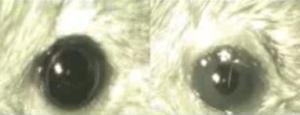
The pupils of mice that were injected with the light-sensitive chemical constricted when exposed to bright light (right) in contrast to mice that were not injected (left). Image from Polosukhina et al., 2012.
By injecting the eyes of blind mice with a chemical called AAQ, Dr. Richard Kramer and colleagues at UC Berkeley and the University of Washington have found that the animals are able to detect bright light. When these treated mice were exposed to an LED lamp, they actually turned and ran away from the light. Moreover, their pupils contracted in response to bright light, another indication of improved light sensitivity.
The light-sensitive chemical works by binding to ion channels on cells in the retina. When the chemical is activated by light, it changes the ion flow through channels thereby activating the visual neurons. Unfortunately, the effects of this chemical wear off rather quickly so the researchers are exploring longer lasting versions.
The hope is that this discovery may lead to treatments for blindness in humans that result from death of the light-sensitive cells in the eyes.
Source:
Polosukhina A, Litt J, Tochitsky I, Nemargut J, Sychev Y, De Kouchkovsky I, Huang T, Borges K, Trauner D, Van Gelder RN, Kramer RH. Photochemical Restoration of Visual Responses in Blind Mice. Neuron. 75(2): 271-282, 2012. DOI: 10.1016/j.neuron.2012.05.022

It's good!